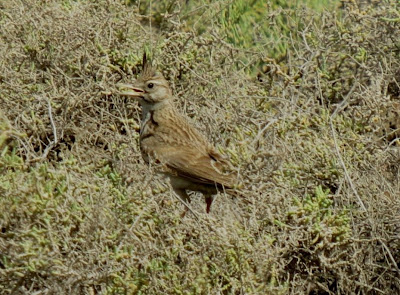common tern
On Thursday I chose to bird watch in one area, staying on foot all the time. This was a strip of land in front of Alba (Aluminium Bahrain) works from the front entrance to the works all the way to the sea. This cross section of land has quite a variety of terrain and is peacefully away from traffic and other disturbance.
Close to the sea, there is a clean fresh water body fed by some water pipe from a factory process. This area was quite productive. On or next to the water were three types of tern. The largest was common tern. The other two species were the smaller Saunder's tern and a single whiskered tern.
Saunder's tern
Interestingly Saunder's tern is very much a coastal bird whereas whiskered tern is a marsh tern often favouring fresh water and can be found a long way inland.
whiskered tern
As I have come to expect any where on Arabian coasts, it was not difficult to find western reef heron.
western reef heron (light and dark morphs)
A single grey heron was also seen at the "lake".
grey heron
Both here and further inland were several black winged stilt.
black winged stilt
In the passage seasons, I have often found that bushes very close to the coast have a higher density of warblers than those only 500 metres further inland. And so it proved once again. A small cluster of bushes near the water body was teeming with a variety of warblers.
willow warbler
Willow warbler were the most plentiful.
chiffchaff
There was at least one chiffchaff among them.
second view of chiffchaff
However there was more variety than this. There were both male and female common whitethroat, a bird which I believe had already finished its passage through central Arabia though clearly not cooler coastal areas.
common whitethroat
There was also a marsh warbler and a European reed warbler in the same bushes. Both these birds were very shy and kept in deep cover for most of the time.
marsh warbler
An Upchers warbler and an Eastern olivaceous warbler had no such qualms about being in the open. This was quite a selection of warblers in such a small cluster of (mostly) tamarisk.
It makes me think that these types of coastal bushes in Bahrain must be very interesting indeed during the peak of the passage season.
red backed shrike
Walking inland but still in a wetland area (partly dried out), warblers were clearly much less numerous. The local graceful prinia were the most obvious.
Three types of shrike were easily seen red-backed shrike, lesser grey shrike and a single masked shrike. Two spotted flycatcher were also observed.
lesser grey shrike
The low scrub near the Alba factory was mostly disappointing with just crested lark, house sparrow and willow warbler.
crested lark
The small number of trees were better. My biggest surprise was in the tree below which not only had white eared bulbul but a male hypocolius. Unfortunately it fled before I could photograph it. Surely it should have gone north along with others, 6 weeks ago.
white eared bulbul
Nevertheless it made a good entry on my brand new Bahrain list.
In the next blog I'll report on Friday's birding spent at an inland wetland and in a farming area. It included a lifer which had been my main target bird for Bahrain.
















No comments:
Post a Comment